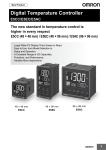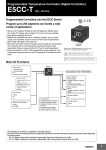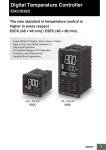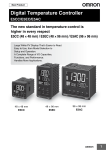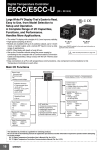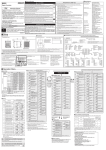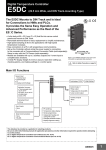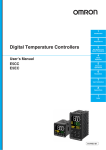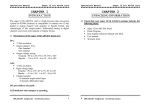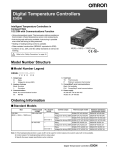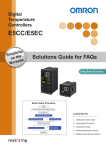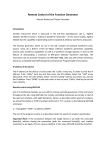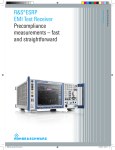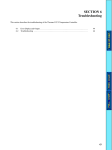Download Omron E5GC Temperature Controller Datasheet
Transcript
Digital Temperature Controller E5GC (48 × 24 mm) Easy Operation and High Performance of the E5@C Series in a Compact 48 × 24mm Body • A compact body of 48 × 24 × 90 mm (W × H × D) that is ideal for small equipment, laboratory instruments, and others. • White PV display with a height of 10.5 mm for high visibility even with the compact body. • Removable terminal block to simplify maintenance. Select from screw terminals or screwless clamp terminals for the wiring method. • High-speed sampling at 50 ms. • Easy connections to a PLC with programless communications. • Set up the Controller without wiring the power supply by connecting to the computer with a Communications Conversion Cable (sold separately). Setup is easy with the CX-Thermo (sold separately). 48 × 24 mm Models with Screw Terminal Blocks E5GC-@6 48 × 24 mm Models with Screwless Clamp Terminal Blocks E5GC-@C Refer to your OMRON website for the most recent information on applicable safety standards. Refer to Safety Precautions on page 104. Main I/O Functions Sensor Input Universal input • Thermocouple • Pt • Analog current/voltage E5GC Dual displays: PV/SV Control Output 1 • Relay output • Voltage output (for driving SSR) • Linear current output Indication Accuracy • Thermocouple input: ±0.3% of PV • Pt input: ±0.2% of PV • Analog input: ±0.2% of FS Sampling Period • 50 ms Event Inputs • None •1 •2 Serial Communications • None • RS-485 4-digit displays • PF (shift) Key • Temperature status display • Simple programming • Independent heating and cooling PID control • Changed parameter display • Display brightness setting • Simple transfer output (only on models with liner current outputs) • Work Bit Message Auxiliary Outputs • None •1 •2 This datasheet is provided as a guideline for selecting products. Be sure to refer to the following manuals for application precautions and other information required for operation before attempting to use the product. E5@C Digital Temperature Controllers User’s Manual (Cat. No. H174) E5@C Digital Temperature Controllers Communications Manual (Cat. No. H175) 2 E5GC Model Number Legend and Standard Models Model Number Legend E5GC-@@ @ @ @ M-@@@ (Example: E5GC-RX1A6M-015) −− − − − − −−− A B C D E F Model A B Control No. of outputs 1 auxiliary and 2 outputs C Power supply voltage D E F Terminal type Input type Options Meaning 48 × 24 mm E5GC Control output 1 Relay output Voltage output (for driving SSR) Linear current output RX QX *1 CX *2 0 1 2 A D 6 C M *3 *3, *4 *5 *1 *2 *3 *4 *5 000 015 016 023 024 Control output 2 None None None None 1 2 100 to 240 VAC 24 VAC/DC Screw terminals (with cover) Screwless clamp terminals Universal input HB alarm and HS alarm Communications Event inputs --------RS-485 ------1 1 --------2 The control output can be used as a simple transfer output. Only option 000 can be selected if an auxiliary output is zero. Option 016 and 023 can be selected only if two auxiliary outputs are selected. Option with HB and HS alarms (023) cannot be selected if a linear current output is selected for the control output. Option 024 can be selected only if one auxiliary output is selected. Heating and Cooling Control ●Using Heating and Cooling Control A Control Output Assignment An auxiliary output is used as the cooling control output. B Control If PID control is used, you can set PID control separately for heating and cooling. This allows you to handle control systems with different heating and cooling response characteristics. 3 E5GC Optional Products (Order Separately) USB-Serial Conversion Cable Model E58-CIFQ2 Model Y92S-P12 Communications Conversion Cable Model E58-CIFQ2-E Current Transformers (CTs) Model E54-CT1 E54-CT3 Mounting Adapter Model Y92F-53 (2pcs) Note: This Mounting Adapter is provided with the Digital Temperature Controller. 4 Note: This Waterproof Packing is provided with the Digital Temperature Controller. Draw-out Jig Note: Always use this product together with the E58-CIFQ2. This Cable is used to connect to the bottom-panel Setup Tool port. Hole diameter 5.8 mm 12.0 mm Waterproof Packing Model Y92F-55 CX-Thermo Support Software Model EST2-2C-MV4 Note: CX-Thermo version 4.62 or higher is required for the E5GC. For the system requirements for the CX-Thermo, refer to information on the EST2-2C-MV4 on the OMRON website (www.ia.omron.com). E5GC Specifications Ratings Power supply voltage Operating voltage range Power consumption Sensor input Input impedance Control method Relay output Control output Auxiliary output Voltage output (for driving SSR) Linear current output Number of outputs Output specifications Number of inputs Event input External contact input specifications Setting method Indication method Multi SP Bank switching Other functions Ambient operating temperature Ambient operating humidity Storage temperature Altitude Recommended fuse Installation environment A in model number: 100 to 240 VAC, 50/60 Hz D in model number: 24 VAC, 50/60 Hz; 24 VDC 85% to 110% of rated supply voltage 5.9 VA max. at 100 to 240 VAC, and 3.2 VA max. at 24 VAC or 1.8 W max. at 24 VDC Temperature input Thermocouple: K, J, T, E, L, U, N, R, S, B, W, or PL II Platinum resistance thermometer: Pt100 or JPt100 Infrared temperature sensor (ES1B): 10 to 70°C, 60 to 120°C, 115 to 165°C, or 140 to 260°C Analog input Current input: 4 to 20 mA or 0 to 20 mA Voltage input: 1 to 5 V, 0 to 5 V, or 0 to 10 V Current input: 150 Ω max., Voltage input: 1 MΩ min. (Use a 1:1 connection when connecting the ES2-HB/ THB.) ON/OFF control or 2-PID control (with auto-tuning) SPST-NO, 250 VAC, 2 A (resistive load), electrical life: 100,000 operations, minimum applicable load: 5 V, 10 mA (reference value) Output voltage 12 VDC ±20% (PNP), max. Load current: 21 mA, with short-circuit protection circuit 4 to 20 mA DC/0 to 20 mA DC, load: 500 Ω max., resolution: Approx. 10,000 1 or 2 (depends on model) SPST-NO relay outputs, 250 VAC, 2 A (resistive load), Electrical life: 100,000 operations, Minimum applicable load: 10 mA at 5 V (reference value) 1 or 2 (depends on model) Contact input ON: 1 kΩ max., OFF: 100 kΩ min. Non-contact input ON: Residual voltage 1.5 V max.; OFF: Leakage current 0.1 mA max. Current flow: approx. 7 mA per contact Digital setting using front panel keys 11-segment digital displays and individual indicators Character height: PV: 10.5 mm, SV: 5.0 mm Up to eight set points (SP0 to SP7) can be saved and selected using the event inputs, key operations, or serial communications.* None Manual output, heating/cooling control, loop burnout alarm, SP ramp, other alarm functions, heater burnout (HB) alarm (including SSR failure (HS) alarm), 40% AT, 100% AT, MV limiter, input digital filter, self tuning, robust tuning, PV input shift, run/stop, protection functions, extraction of square root, MV change rate limit, logic operations, temperature status display, simple programming, moving average of input value, display brightness setting, simple transfer output, and work bit message −10 to 55°C (with no condensation or icing), For 3-year warranty: −10 to 50°C with standard mounting (with no condensation or icing) 25% to 85% −25 to 65°C (with no condensation or icing) 2,000 m max. T2A, 250 VAC, time-lag, low-breaking capacity Installation Category II, Pollution Degree 2 (IEC 61010-1 compliant) * Only four set points are selectable for event inputs. 5 E5GC Input Ranges ●Thermocouple/Platinum Resistance Thermometer (Universal inputs) Sensor type Platinum resistance thermometer Sensor specification Pt100 Infrared temperature sensor Thermocouple JPt100 K J T E L U N R S B W PLII 10 to 70°C 60 to 120°C 115 to 165°C 120 165 140 to 260°C 2300 2300 1800 1800 1700 1700 1700 Temperature range (°C) 1600 1500 1400 1300 1300 1300 1300 1200 1100 1000 900 850 850 850 800 700 600 600 500.0 500 500.0 500.0 400.0 400 400 400.0 400 400.0 260 300 200 100.0 100 Set value 90 100 0.0 -100 -200 100.0 -200 -199.9 0 1 0.0 -199.9 2 3 -20.0 -100 -20.0 6 7 8 -200 4 5 0 0 16 17 0 0 0 0 0 0 19 20 21 22 23 24 -100 -200 -199.9 -200 9 10 11 -200 -199.9 -200 12 13 14 15 18 Shaded settings are the default settings. The applicable standards for the input types are as follows: K, J, T, E, N, R, S, B: JIS C 1602-1995, IEC 60584-1 L: Fe-CuNi, DIN 43710-1985 U: Cu-CuNi, DIN 43710-1985 W: W5Re/W26Re, ASTM E988-1990 JPt100: JIS C 1604-1989, JIS C 1606-1989 Pt100: JIS C 1604-1997, IEC 60751 PL II: According to Platinel II electromotive force charts from BASF (previously Engelhard) ●Analog input Input type Input specification Setting range Set value 6 Current Voltage 4 to 20 mA 0 to 20 mA 1 to 5 V 0 to 5 V Usable in the following ranges by scaling: -1999 to 9999, -199.9 to 999.9, -19.99 to 99.99 or -1.999 to 9.999 25 26 27 28 0 to 10 V 29 E5GC Alarm Types Each alarm can be independently set to one of the following 17 alarm types. The default is 2: Upper limit. (See note.) Auxiliary outputs are allocated to alarms. ON delays and OFF delays (0 to 999 s) can also be specified. Note: In the default settings for models with HB or HS alarms, alarm 1 is set to a heater alarm (HA) and the Alarm Type 1 parameter is not displayed. To use alarm 1, set the output assignment to alarm 1. Set value Alarm type 0 Alarm function OFF 1 Upper- and lower-limit *1 2 Upper-limit (default) 3 Lower-limit 4 Upper- and lower-limit range *1 5 6 7 8 9 10 11 Alarm output operation Description of function When alarm value X When alarm value X is positive is negative Output OFF No alarm Set the upward deviation in the set point for the alarm upper L H limit (H) and the lower deviation in the set point for the alarm ON *2 OFF PV lower limit (L). The alarm is ON when the PV is outside this SP deviation range. Set the upward deviation in the set point by setting the alarm X X ON ON value (X). The alarm is ON when the PV is higher than the OFF PV OFF PV SP SP SP by the deviation or more. Set the downward deviation in the set point by setting the X X ON ON alarm value (X). The alarm is ON when the PV is lower than OFF PV OFF PV SP SP the SP by the deviation or more. Set the upward deviation in the set point for the alarm upper L H limit (H) and the lower deviation in the set point for the alarm ON *3 OFF PV lower limit (L). The alarm is ON when the PV is inside this deSP viation range. Upper- and lower-limit with standby sequence *1 *5 Upper-limit with standby sequence Lower-limit with standby sequence ON OFF Absolute-value upper-limit ON OFF Absolute-value lower-limit ON OFF Absolute-value upper-limit with standby sequence ON OFF Absolute-value lower-limit with standby sequence ON OFF LBA (alarm 1 type only) PV change rate alarm 14 SP absolute-value upper-limit alarm ON OFF SP absolute-value lower-limit alarm ON OFF X SP PV ON OFF PV ON OFF PV ON OFF PV ON OFF PV ON OFF PV ON OFF X SP X 0 X 0 X 0 X 0 X 0 PV A standby sequence is added to the upper-limit alarm (2). *6 PV A standby sequence is added to the lower-limit alarm (3). *6 X SP X 0 PV X 0 PV X 0 PV X 0 PV ON OFF SP ON OFF X 0 The alarm will turn ON if the process value is smaller than the alarm value (X) regardless of the set point. A standby sequence is added to the absolute-value upperlimit alarm (8). *6 A standby sequence is added to the absolute-value lowerlimit alarm (9). *6 X 0 SP X 0 SP This alarm type turns ON the alarm when the set point (SP) is higher than the alarm value (X). This alarm type turns ON the alarm when the set point (SP) is lower than the alarm value (X). Standard Control X MV 0 The alarm will turn ON if the process value is larger than the alarm value (X) regardless of the set point. *7 *8 SP ON OFF X 0 MV X MV 0 Standard Control ON OFF 17 SP This alarm type turns ON the alarm when the manipulated Heating/Cooling Heating/Cooling variable (MV) is higher than the alarm value (X). Control (Heating MV) Control (Heating MV) ON OFF MV absolute-value lower-limit alarm *9 X - ON OFF MV absolute-value upper-limit alarm *9 *4 PV Standard Control 16 A standby sequence is added to the upper- and lower-limit alarm (1). *6 H SP ON OFF 12 13 15 L ON OFF Standard Control X MV 0 Always ON ON OFF X 0 MV This alarm type turns ON the alarm when the manipulated Heating/Cooling Heating/Cooling variable (MV) is lower than the alarm value (X). Control (Cooling MV) Control (Cooling MV) ON OFF X 0 MV Always ON 7 E5GC *1 With set values 1, 4, and 5, the upper- and lower-limit values can be set independently for each alarm type, and are expressed as “L” and “H.” *2 Set value: 1, Upper- and lower-limit alarm Case 3 (Always OFF) Case 2 Case 1 H<0, L<0 L H SP H<0, L>0 |H| < |L| H SP L H H>0, L<0 |H| > |L| H SP L H<0, L>0 |H| ≥ |L| L SP SP H L H>0, L<0 |H| ≤ |L| *3 Set value: 4, Upper- and lower-limit range Case 3 (Always ON) Case 2 Case 1 H<0, L<0 L H SP H<0, L>0 |H| < |L| SP L H H H>0, L<0 |H| > |L| H SP L L SP SP H L 8 H<0, L>0 |H| ≥ |L| H>0, L<0 |H| ≤ |L| *4 Set value: 5, Upper- and lower-limit with standby sequence For Upper- and Lower-Limit Alarm Described Above at *2 • In cases 1 and 2 above, the alarm is always OFF if the upperand lower-limit hysteresis overlaps. • In case 3, the alarm is always OFF. *5 Set value: 5, Upper- and lower-limit alarm with standby sequence The alarm is always OFF if upper- and lower-limit hysteresis overlaps. *6 Refer to the E5@C Digital Temperature Controllers User’s Manual (Cat. No. H174) for information on the operation of the standby sequence. *7 Refer to the E5@C Digital Temperature Controllers User’s Manual (Cat. No. H174) for information on the LBA. *8 Refer to the E5@C Digital Temperature Controllers User’s Manual (Cat. No. H174) for information on the PV change rate alarm. *9 When heating/cooling control is performed, the MV absolutevalue upper-limit alarm functions only for the heating operation and the MV absolute-value lower-limit alarm functions only for the cooling operation. E5GC Characteristics Indication accuracy (at the temperature of 23°C) Influence of temperature *2 Influence of voltage *2 Input sampling period Hysteresis Proportional band (P) Integral time (I) Derivative time (D) Proportional band (P) for cooling Integral time (I) for cooling Derivative time (D) for cooling Control period Manual reset value Alarm setting range Influence of signal source resistance Insulation resistance Thermocouple: (±0.3 % of indication value or ±1°C, whichever is greater) ±1 digit max.*1 Platinum resistance thermometer: (±0.2 % of indication value or ±0.8°C, whichever is greater) ±1 digit max. Analog input: ±0.2% FS ±1 digit max. CT input: ±5% FS ±1 digit max. Thermocouple input (R, S, B, W, PL II): (±1% of indication value or ±10°C, whichever is greater) ±1 digit max. Other thermocouple input: (±1% of indication value or ±4°C, whichever is greater) ±1 digit max. *3 Platinum resistance thermometer: (±1% of indication value or ±2°C, whichever is greater) ±1 digit max. Analog input: ±1% FS ±1 digit max. CT input: ±5% FS ±1 digit max. 50 ms Temperature input: 0.1 to 999.9°C or °F (in units of 0.1°C or °F) Analog input: 0.01% to 99.99% FS (in units of 0.01% FS) Temperature input: 0.1 to 999.9°C or °F (in units of 0.1°C or °F) Analog input: 0.1% to 999.9% FS (in units of 0.1% FS) 0 to 9999 s (in units of 1 s), 0.0 to 999.9 s (in units of 0.1 s) *4 0 to 9999 s (in units of 1 s), 0.0 to 999.9 s (in units of 0.1 s) *4 Temperature input: 0.1 to 999.9°C or °F (in units of 0.1°C or °F) Analog input: 0.1% to 999.9% FS (in units of 0.1% FS) 0 to 9999 s (in units of 1 s), 0.0 to 999.9 s (in units of 0.1 s) *4 0 to 9999 s (in units of 1 s), 0.0 to 999.9 s (in units of 0.1 s) *4 0.1, 0.2, 0.5, 1 to 99 s (in units of 1 s) 0.0% to 100.0% (in units of 0.1%) −1,999 to 9,999 (decimal point position depends on input type) Thermocouple: 0.1°C/Ω max. (100 Ω max.), Platinum resistance thermometer: 0.1°C/Ω max. (10 Ω max.) 20 MΩ min. (at 500 VDC) 100 to 240 VAC: 3,000 VAC, 50/60 Hz for 1 min between terminals of different charge Dielectric strength 24 VAC/DC: 2,300 VAC, 50/60 Hz for 1 min between terminals of different charge Malfunction 10 to 55 Hz, 20 m/s2 for 10 min each in X, Y and Z directions Vibration Resistance 10 to 55 Hz, 20 m/s2 for 2 hr each in X, Y, and Z directions Malfunction 100 m/s2, 3 times each in X, Y, and Z directions Shock Resistance 300 m/s2, 3 times each in X, Y, and Z directions Weight Controller: Approx. 80 g, Adapter: Approx. 4 g × 2 Degree of protection Front panel: IP66, Rear case: IP20, Terminals: IP00 Memory protection Non-volatile memory (number of writes: 1,000,000 times) Setup Tool CX-Thermo version 4.62 or higher E5GC side panel: An E58-CIFQ2 USB-Serial Conversion Cable is used to connect a USB port on the computer. *5 Setup Tool port E5GC bottom panel: An E58-CIFQ2 USB-Serial Conversion Cable and E58-CIFQ2-E Conversion Cable are used together to connect a USB port on the computer.*5 Approved standards UL 61010-1, Korean Radio Waves Act (Act 10564) Standards Conformed standards EN 61010-1 (IEC 61010-1): Pollution Degree 2 , overvoltage category II EMI: EN61326 Radiated Interference Electromagnetic Field Strength: EN55011 Group 1, class A Noise Terminal Voltage: EN55011 Group 1, class A EMS: EN61326 ESD Immunity: EN61000-4-2 EMC Electromagnetic Field Immunity: EN61000-4-3 Burst Noise Immunity: EN61000-4-4 Conducted Disturbance Immunity: EN61000-4-6 Surge Immunity: EN61000-4-5 Voltage Dip/Interrupting Immunity: EN61000-4-11 *1 The indication accuracy of K thermocouples in the −200 to 1,300°C range, T and N thermocouples at a temperature of −100°C max., and U and L thermocouples at any temperature is ±2°C ±1 digit max. The indication accuracy of B thermocouples at a temperature of 400°C max. is not specified. The indication accuracy of B thermocouples at a temperature of 400 to 800°C is ±3°C max. The indication accuracy of R and S thermocouples at a temperature of 200°C max. is ±3°C ±1 digit max. The indication accuracy of W thermocouples is (±0.3% of PV or ±3°C, whichever is greater) ±1 digit max. The indication accuracy of PLII thermocouples is (±0.3% of PV or ±2°C, whichever is greater) ±1 digit max. *2 Ambient temperature: −10°C to 23°C to 55°C, Voltage range: −15% to 10% of rated voltage *3 K thermocouple at −100°C max.: ±10°C max. *4 The unit is determined by the setting of the Integral/Derivative Time Unit parameter. *5 External serial communications (RS-485) and USB-Serial Conversion Cable communications can be used at the same time. 9 E5GC USB-Serial Conversion Cable Applicable OS Windows XP/Vista/7/8 Applicable software CX-Thermo version 4.62 or higher Applicable models E5@C-T Series, E5@C Series, and E5CB Series Component Communications When Digital Temperature Controllers are connected, set points and RUN/STOP commands can be sent from the Digital Temperature Controller that is set as the master to the Digital Temperature Controllers that are set as slaves. Slope and offsets can be set for the set point. Number of connected Digital Temperature Controllers: 32 max. (including master) Copying* When Digital Temperature Controllers are connected, the parameters can be copied from the Digital Temperature Controller that is set as the master to the Digital Temperature Controllers that are set as slaves. USB interface standard Conforms to USB Specification 2.0 DTE speed 38,400 bps Connector specifications Computer: USB (Type A plug) Digital Temperature Controller: Special serial connector Power supply Bus power (Supplied from the USB host controller) * MELSEC is a registered trademark of Mitsubishi Electric Corporation. KEYENCE is a registered trademark of Keyence Corporation. Power supply voltage 5 VDC * Current consumption 450 mA max. Output voltage 4.7±0.2 VDC (Supplied from USB-Serial Conversion Cable to the Digital Temperature Controller.) Output current 250 mA max. (Supplied from USB-Serial Conversion Cable to the Digital Temperature Controller.) Ambient operating temperature 0 to 55°C (with no condensation or icing) Ambient operating humidity 10% to 80% Storage temperature −20 to 60°C (with no condensation or icing) Storage humidity 10% to 80% Altitude 2,000 m max. Weight Approx. 120 g * Use a high-power port for the USB port. Note: A driver must be installed on the computer. Refer to the Instruction Manual included with the Cable for the installation procedure. Communications Specifications Transmission line connection method RS-485: Multidrop Communications RS-485 (two-wire, half duplex) Synchronization method Start-stop synchronization Protocol CompoWay/F, or Modbus Baud rate* 9,600, 19,200, 38,400, or 57,600 bps Transmission code ASCII Data bit length * 7 or 8 bits Stop bit length * 1 or 2 bits Error detection Vertical parity (none, even, odd) Block check character (BCC) with CompoWay/F or CRC-16 with Modbus Flow control None Interface RS-485 Retry function None Communications buffer 217 bytes Communications response wait time 0 to 99 ms Default: 20 ms * The baud rate, data bit length, stop bit length, and vertical parity can be individually set using the Communications Setting Level. Communications Functions Programless communications 10 You can use the memory in the PLC to read and write E5@C parameters, start and stop operation, etc. The E5@C automatically performs communications with PLCs. No communications programming is required. Number of connected Digital Temperature Controllers: 32 max. (Up to 16 for the FX Series) Applicable PLCs: OMRON PLCs CS Series, CJ Series, or CP Series Mitsubishi Electric PLCs MELSEC Q Series, L Series, or FX Series (compatible with the FX2 or FX3 (excluding the FX1S)) KEYENCE PLCs KEYENCE KV Series Current Transformer (Order Separately) Ratings Dielectric strength 1,000 VAC for 1 min Vibration resistance 50 Hz, 98 m/s2 Weight E54-CT1: Approx. 11.5 g, E54-CT3: Approx. 50 g Accessories (E54-CT3 only) Armatures (2) Plugs (2) Heater Burnout Alarms and SSR Failure Alarms CT input (for heater current detection) Models with detection for single-phase heaters: One input Maximum heater current 50 A AC Input current indication accuracy ±5% FS ±1 digit max. Heater burnout alarm setting range *1 0.1 to 49.9 A (in units of 0.1 A) Minimum detection ON time: 100 ms *3 SSR failure alarm setting range *2 0.1 to 49.9 A (in units of 0.1 A) Minimum detection OFF time: 100 ms *4 *1 *2 *3 *4 For heater burnout alarms, the heater current will be measured when the control output is ON, and the output will turn ON if the heater current is lower than the set value (i.e., heater burnout detection current value). For SSR failure alarms, the heater current will be measured when the control output is OFF, and the output will turn ON if the heater current is higher than the set value (i.e., SSR failure detection current value). The value is 30 ms for a control period of 0.1 s or 0.2 s. The value is 35 ms for a control period of 0.1 s or 0.2 s. Electrical Life Expectancy Curve for Control Output Relay (Reference Values) Life (× 104 operations) Windows is a registered trademark of Microsoft Corporation in the United States and or other countries. Both the programless communications and the component communications support the copying. 500 300 200 100 E5GC 250 VAC, 30 VDC (resistive load) cosφ = 1 50 30 20 10 5 3 2 1 0.1 0.2 0.3 0.5 1 2 3 5 10 Switching current (A) E5GC External Connections E5GC Control Outputs E5GC-@ @ @ @ @ M - @ @ @ Relay output 250 VAC, 2 A (resistive load) Voltage output (for driving SSR) 12 VDC, 21 mA Linear current output 0 to 20 mA DC 4 to 20 mA DC Load: 500 Ω max. (1) (2)(3)(4)(5) (6) ↑ Terminal type Auxiliary outputs 1, 2 The E5GC is set for a K-type thermocouple (input type = 5) by default. An input error (s.err) wil occur if the input type setting does not agree with the temperature sensor. Check the input type. Relay outputs 250 VAC, 2 A (resistive load) (6) Options 015 Communications (RS-485) RS-485 B(+) 016 023 Event input 1 CT input EV1 A(−) − + 7 8 (5) Sensor (Temperature/ Analog) Input 024 Event inputs 1 and 2 EV2 CT − + − + EV1 + TC 10 11 12 7 8 9 9 7 8 7 9 8 9 B A Pt (3) Input Power Supply 100 to 240 VAC 1 B 10 11 12 + mA − 24 VAC/DC 2 1 2 7 8 9 10 11 12 1 2 3 I 10 11 12 − (no polarity) 4 5 6 V V + 10 11 12 (2) Auxiliary Outputs Auxiliary output 1 (1) Control Outputs RX QX Relay output R Voltage output (for driving SSR) Linear current output Q C CX + − + 9 − 5 3 4 3 4 3 Auxiliary outputs 1, 2 Auxiliary output 2 4 5 6 Auxiliary output 1 6 Auxiliary output 1 Note: 1. The application of the terminals depends on the model. 2. Do not wire the terminals that are shown with a gray background. 3. When complying with EMC standards, the cable that connects the sensor must be 30 m or less. If the cable length exceeds 30 m, compliance with EMC standards will not be possible. 4. Connect M3 crimped terminals. Isolation/Insulation Block Diagrams Sensor input and CT input Communications and event inputs Power supply Voltage output (for driving SSR) and linear current output Relay output Auxiliary outputs 1 and 2 : Reinforced insulation : Functional isolation Note: Auxiliary outputs 1 to 2 are not insulated. 11 E5GC Wiring Methods E5GC-@C Controllers with Screwless Clamp Terminal Blocks E5GC-@6 Controllers with Screw Terminal Blocks (M3 Screws) Controllers with Screw Terminal Blocks Controllers with Screwless Clamp Terminals Blocks • Terminal type: Forked or round crimped terminals • Tightening torque for all terminals: 0.43 to 0.58 N·m • Wire stripping length: 8 to 12 mm • Ferrules: 8 to 12 mm 0.8 to 1.4 mm 5.8 mm max. 8 to 12 mm 8 to 12 mm 5.8 mm max. Wires: AWG24 to AWG18 (equal to a cross-sectional area of 0.205 to 0.823 mm2) braided or solid wires Nomenclature E5GC Front panel Left Side View of the E5GC Left-panel Setup Tool port No. 1 display Temperature unit PV or specified parameter No.2 display SP or specified parameter value Bottom View of E5GC Operation indicators Press O Key once to go to Adjustment Level. Use the U D Keys to set the parameter. Press O Key for at least 3 seconds to go to the Initial Setting Level. Bottom-panel Setup Tool port Use the M Key to change to another parameter. 12 Use S Key to change the digit (default setting). E5GC Dimensions (Unit: mm) Controllers E5GC-@6 Controllers with Screw Terminal Blocks Waterproof Packing (Accessory) 63.6 48 Mounting Adapter (Accessory) Terminal Cover (Accessory) 4 90 44.8 1 22 40.8 24 22 • Use two Mounting Adapters, either on the top and bottom or on the right and left. • Setup Tool ports are provided as standard feature. Use these ports to connect a computer to the Digital Temperature Controller. The E58CIFQ2 USB-Serial Conversion Cable is required to connect to the port on the side panel. The E58-CIFQ2 USB-Serial Conversion Cable and E58-CIFQ2-E Communications Conversion Cable are required to connect to the port on the bottom panel. (You cannot leave either port connected constantly during operation.) Mounted Separately Horizontally Group Mounted L1 To mount the Temperature Controller so that it is waterproof, insert the Waterproof Packing onto the Temperature Controller. Group mounting does not allow waterproofing. 22.2+0.3 0 40 min 45+0.60 L1=(48×n-2.5) 22.2+0.3 0 +1.0 +0 n: Number of mounted Controllers (2 ≤ n ≤ 6) • To install the Temperature Controller, insert it into a square hole in a panel with a thickness of 1 to 8 mm, and then insert the enclosed adapter so that it locks into the grooves on the top and bottom or on the left and right of the rear case. • Tighten the two mounting screws on the top and bottom or on the right and left of the Mounting Adapters alternately little by little to maintain a balance, and tighten them to a torque of between 0.29 and 0.39 N·m. • When two or more Temperature Controllers are mounted, make sure that the surrounding temperature does not exceed the allowable operating temperature range given below. Horizontal group mounting: −10 to 55°C • Use Temperature Controllers with Screwless Clamp Terminal Blocks for vertical group mounting. E5GC-@C Controllers with Screwless Clamp Terminal Blocks Waterproof Packing (Accessory) Mounting Adapter (Accessory) 63.6 48 4 93 44.8 1 22 40.8 24 22 • Use two Mounting Adapters, either on the top and bottom or on the right and left. • Setup Tool ports are provided as standard feature. Use these ports to connect a computer to the Digital Temperature Controller. The E58CIFQ2 USB-Serial Conversion Cable is required to connect to the port on the side panel. The E58-CIFQ2 USB-Serial Conversion Cable and E58-CIFQ2-E Communications Conversion Cable are required to connect to the port on the bottom panel. (You cannot leave either port connected constantly during operation.) Mounted Separately Horizontally Group Mounted Vertically Group Mounted 45 L1 +0.6 +0 22.2+0.3 0 40 min 45+0.60 L1=(48×n-2.5) +1.0 +0 n: Number of mounted Controllers (2 ≤ n ≤ 6) 22.2+0.3 0 L2 To mount the Temperature Controller so that it is waterproof, insert the Waterproof Packing onto the Temperature Controller. Group mounting does not allow waterproofing. L2=(24×n-1.5) +1.0 +0 • To install the Temperature Controller, insert it into a square hole in a panel with a thickness of 1 to 8 mm, and then insert the enclosed adapter so that it locks into the grooves on the top and bottom or on the left and right of the rear case. • Tighten the two mounting screws on the top and bottom or on the right and left of the Mounting Adapters alternately little by little to maintain a balance, and tighten them to a torque of between 0.29 and 0.39 N·m. • When two or more Temperature Controllers are mounted, make sure that the surrounding temperature does not exceed the allowable operating temperature range given below. Horizontal group mounting: −10 to 55°C Vertical group mounting of two Controllers: −10 to 45°C Vertical group mounting of three or more Controllers: −10 to 40°C • If you use vertical group mounting, you cannot draw out the interior body of the Controller. 13 E5GC Accessories (Order Separately) ● USB-Serial Conversion Cable E58-CIFQ2 (2110) 250 263 1510 LED (RD) USB connector (type A plug) Serial connector LED (PWR) LED (SD) ● Conversion Cable E58-CIFQ2-E Conversion Cable Connecting to the E58-CIFQ2 USB-Serial Conversion Cable (2110) (1510) 250 263 1510 E58-CIFQ2 (Order separately) Note: Always use this product together with the E58-CIFQ2. Conversion Cable ● Current Transformers E54-CT1 21 15 Thru-current (Io) vs. Output Voltage (Eo) (Reference Values) E54-CT1 2.8 5.8 dia. 7.5 3 Output voltage (Eo) V (r.m.s.) 25 Maximum continuous heater current: 50 A (50/60 Hz) Number of windings: 400±2 Winding resistance: 18±2 Ω 10.5 40 Two, 3.5 dia. 10 30 100V Frequency: 50 Hz ∞ 1kΩ 10 Distortion factor 10% 1 3% 1% 100mV 100Ω 10 E54-CT3 2.36 dia. 30 RL=10Ω 1 12 dia. 9 100μV 10 1 40 × 40 10 100mA 1 10 100 1,000A Thru-current (Io) A (r.m.s.) Two , M3 holes (depth: 4) 30 Connection Example Armature Plug Approx. 3 dia. Lead 18 Output voltage (Eo) V (r.m.s.) Maximum continuous heater current: 120 A (50/60 Hz) (Maximum continuous heater current for an OMRON Digital Temperature Controller is 50 A.) Number of windings: 400±2 Winding resistance: 8±0.8 Ω 15 E54-CT3 Accessories • Armature Thru-current (Io) vs. Output Voltage (Eo) (Reference Values) E54-CT3 100V Frequency: 50 Hz Distortion factor 10% 3% 1% ∞ 1kΩ 500Ω 10 1 100mV 100Ω 50Ω 10 RL=10Ω • Plug 1 Approx. 6 dia. 100μV (22) 10 1 10 100mA 1 10 100 1,000A Thru-current (Io) A (r.m.s.) 14














